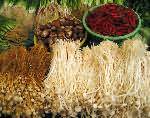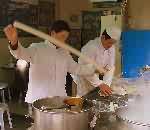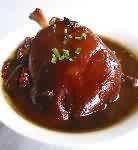- Getting around Lijiang. Dont stay in the Old Towns more than 2 days, there is nothing to do. KRISS Oct 9, 2013 05:46
- 2013 Beijing Temple Fair BENNYLAU Feb 26, 2013 03:29
- Malaysian traveling from KUL - LAX vis Shanghai PVG ZATI_DY Jan 3, 2013 20:15
<A>Shanghai's Culinary Delights
- Views: 5596
- |Vote: 0 0
- |Add to Favorites
- |Recommend to Friends
China's culinary diversity is reflected in its many regional cuisines. On a recent visit to Shanghai I was able to sample the specialties of a city booming with economic development yet still steeped in delectable gastronomic history and tradition.
The old Chinese quarter of the city (Nanshi) south west of the Bund is a great place to spend a day to still experience the traditional Chinese way of life, especially the food culture. It seems strange to find a place referred to as 'Chinatown' in China but it's so named as the Chinese inhabited this section of the city during the European colonial era in the 19th and early 20th centuries. Today it's a small pocket of tradition in a modern high rise city. The main aspects of which are centred around the family, community and food. The narrow streets lined with adjoining ancient houses are filled with residents shopping, playing mah jong or simply chatting with neighbours. Though economically poor I felt a strong sense of community among the residents.
From a culinary aspect, a fantastic wet market covering several blocks operates from Dajing Lu (road). Market sellers offering super fresh produce ranging from flipping fish swimming in aerated basins, live chickens, all cuts of pork to seasonal fruits & vegetables, tofu, noodles, duck eggs and much more. This market exemplifies what it means to purchase fresh ingredients. All the produce is local, seasonal, unprocessed and barely packaged. The experience reminds you of how food should be bought, not from styrofoam trays piled in sterile supermarkets. Living in this neighbourhood provides a cook with the luxury of buying fresh ingredients everyday.
It is commonly believed in the West that rice is the staple food of the Chinese, this is only true of Southern China where the climate is suitable for its cultivation. The most ubiquitous food in China is noodles. Archeological evidence reveals that noodles were consumed in China at least 5000 years ago. Noodles are made from different ingredients: wheat, rice, buckwheat and mung bean. Shanghai wheat noodles are as thick as spaghetti with a soft texture, unlike Cantonese noodles which are string thin and firm to bite.
Found in the narrow bustling streets of Nanshi are traditional Shanghai 'hand pulled' noodles houses that feature master noodles makers. To prepare your bowl of noodles, they take a large piece of dough and apply many different skills such as rolling, rubbing, stretching, kneading, curling, pressing and swinging. In a matter of minutes with great speed and dexterity the dough is transformed into a bunch of fine even strands. It's then swung into a cauldron of boiling water and boiled for 30 seconds, no longer as over cooked noodles loose their 'bite'. It's essential not to serve soft mushy noodles as texture is all important. The noodle broth is a hearty, tasty chicken and pork stock. Always season with the chilli paste for a fantastic aroma and zing. All this for only 3 yuan (50 cents).
The hand pulled noodles should have stimulated your appetite in preparation to try Shanghai's favourite snack xiaolongbao literally 'little steamer buns'. Steamed dumplings are found all over China, but the Shanghai variety is particularly delicious and clever. Shanghainese dumplings are described as elegantly twisted morsels full of pork. The surprise is the gush of tasty, scalding soup when the dumpling is bitten. The dough wrapper acts as a water tight container for a mixture of seasoned ground pork and a gelatinous soup. After steaming, the gelatin melts, bathing the pork in a delicious hot stock, all inside the wrapper. To avoid burning your tongue, hold the dumplings over a spoon and nibble at the top to allow the soup to dribble into it or wait few moments for the soup to cool before swallowing the dumpling whole.
Yu's Gardens Bazzar is one of the most popular places to try xiaolongbao. This traditional style shopping and eating area is located at the north-eastern end of the old Chinese quarter and frequented by tourists and locals alike. Commonly seen are the extremely long queues for take away dumplings. The shops display workers making the dumplings behind glass. I was too hungry to wait in the snaking queue so I went inside and paid a little more to eat the dumplings at a table. Fill yourself up with a dozen or so for only 15 yuan, 25 if you want the dumplings topped with crab.
After satiating your appetite with noodles and dumplings, a stop at the famous Huxinting tea house is a welcome tranquil respite. The Huxinting tea house offers high quality tea at 'quality' prices but the tea is served with traditional snacks and live music so the expense is worth the experience. The tea house is a traditional place of leisure where friends gather to relax and chat while enjoying tea and local delicacies.
There are hundreds of varieties of Chinese tea but the main types are: green tea, black tea, brick tea, scented tea, and Oolong tea. This tea house offers a good selection. Tea is a fundamental aspect of Chinese culture with evidence showing it was first drunk at least two thousand years ago. Many Chinese consume tea several times a day as a refreshment and health ritual. Tea contains many vitamins, anti-oxidants, minerals and more. The Chinese believe that drinking tea will prolong life by preventing disease which scientific studies have confirmed.
When dinner time arrives you'll be spoilt for choice as Shanghai restaurants just keep getting better and better. Two popular foods to be found in eateries serving local fare are pork knuckle and hairy crab. Delectable to the bone, the pork knuckle is braised for 2-3 hours in quality soy sauce, rice wine, sugar and ginger until it's melt in your mouth tender. For seafood lovers, the celebrated hairy crab is a must particularly when it reaches its prime in the autumn. The meat is tender, sweet, nutritious and emanates a heady fragrance. This steamed dished is served with ginger, vinegar and is perfectly matched with warmed Shaoxing rice wine.
Gourmands will truly be fulfilled with the culinary offerings of Shanghai. The range of tastes, aromas and textures will surprise, delight and definitely have you coming back for more.







 Copyright © 1998-2025 All rights reserved.
Copyright © 1998-2025 All rights reserved.
1.
Apr 13, 2005 10:23 Reply
DEE0228 said:
It's a great pleasure to read your article. I feel hungry now!